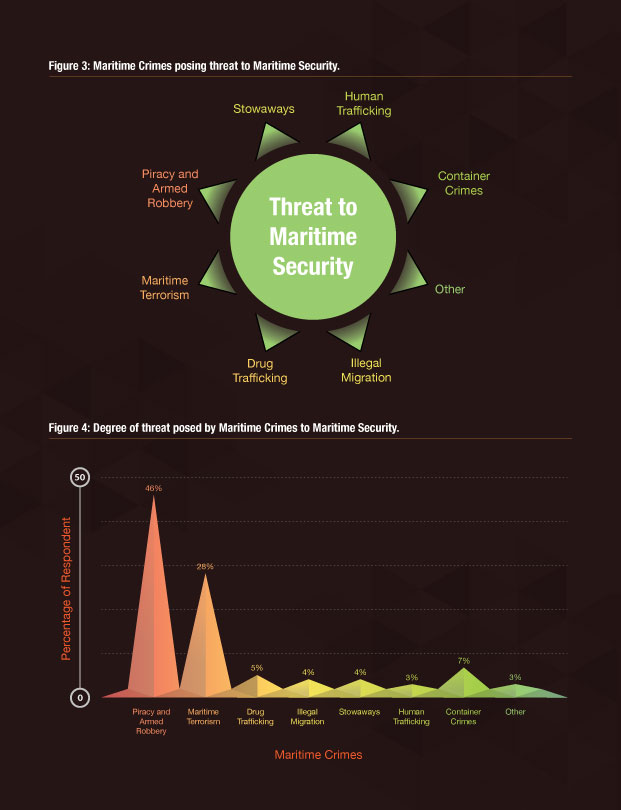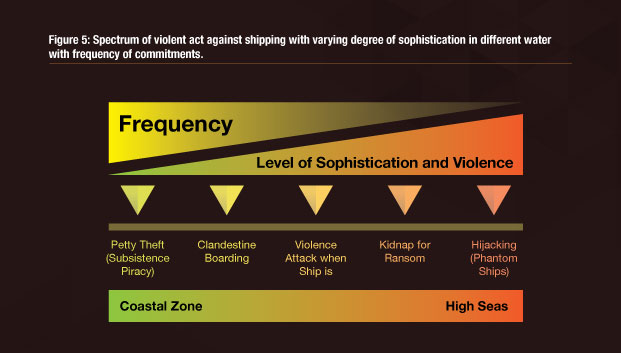Fears and Facts in Maritime Security
Overview of Maritime Security and Definitions
For ages, shipping has been vulnerable to various maritime crimes. The collected data from maritime security incidents is a clear reflection of the fact that the industry was exposed to multiple maritime crimes year after year. Threats to the maritime industry were also seen during the Iran-Iraq war days. Numerous ships and maritime infrastructure were targeted during the period 1980- 1988. The hijacking of the Achille Lauro on October 7, 1985, an Italian cruise ship carrying 400 passengers by the Palestinian Liberation Front and killing of 69-year-old Leon Klinghoffer, a Jewish-American exposed the lack of security in the industry. This incident raised concerns among the International Maritime Organization member states, as it threatened numerous human lives.
The terrorist attack on the United States in 2001 further drew the attention of the world to the severity of the crime that may be committed and the level of motivation of the perpetrators. The hijacking of an aircraft is rare as it involves the crossing of several security barriers in the presence of security officials. However, no such barriers exist when a ship is at sea. Criminals can easily board a ship, overpower the crew and exploit it for achieving their goals. Some security experts fear that the biggest nightmare would be if a ship carrying explosive cargo, like LNG, were to be hijacked to be used as Weapon of Mass Destruction (WMD). The extent of damage that could be caused in such case can be seen from the collision between Norwegian steamer, Belgian relief ship Imo and ammunition steamer Mont Blanc on December 6, 1917, in Halifax Harbor. The collision resulted in an explosion that destroyed more than 325 acres of Halifax city, killing more than 1600 people, injuring more than 9,000, and destroying more than 12,000 buildings.
Maritime Security Definitions
Maritime security has been defined in different ways, some of which are provided below for looking into the objectives of maritime security. Definition of maritime security could be given as “those measures employed by owners, operators, and administrators of vessels, port facilities, offshore installations and other marine organizations or establishments to protect against any hostile interference with lawful operations.”
According to Steven M. Jones maritime security is “the state of a shipping company/vessel/crew/port, being or feeling secure or the safety of a shipping company/vessel/crew/port against such threats as terrorism, piracy, and other criminal activities.”
Another definition by Mejia states maritime security as “... the state of being free from the threat of unlawful acts such as piracy, armed robbery, terrorism, or any other form of violence against ships, crews, passengers, port facilities, offshore installations, and other targets at sea or in coastal areas.
In maritime studies, the term maritime security is differentiated from the term maritime safety which deals with preventing accidents at sea that may be caused by, inter alia, fortuitous incidents, substandard ships, unqualified crew, or operator errorFrom the beginnings, International Shipping has been the most liberal form of transportation with a high degree of flexibility in its movement. This very nature of shipping inculcated fearlessness in the system, resulting in lack of investment for the training of personnel and infrastructure development for maritime security, and a general lack of understanding of the threats posed to the ships and their crews. This article will provide an overview of the maritime security and dwell on some definitions, the vulnerability of the maritime sector to the crimes such as piracy, armed robbery against ships and maritime terrorism, and finally the preventive measures that are available in the form of international instruments.
Fears and Facts in Maritime Security
Maritime security risks to the industry range from terrorizing of the crew, hijacking of ships and attacks on ships and port facilities to disrupt the supply chain so as to causing economic losses. Ransom money involved for release of hijacked ships and their crews ranges from $1million to $20 million, and some experts estimate that the value of cargo lost per hijacked merchandise ships is between $8 million and $200 million.
In the past, it has been seen that ships have been used for illegally transporting weapons of mass destruction, explosives, illegal materials and contrabands, and terrorists as stowaways. Confiscation of an assembly line for ballistic missiles by Indian customs officials at the port of Kandla on June 30, 1999, and seizure of approximately 8,000 assault rifles and automatic weapons from three cargo containers by Italian customs officials in the port of Gioia Tauro on April 10, 2004, are examples of illegal activities.
Shipping is the most affordable and luxury means of transportation for the more than 12 million passengers cruising each year. Passenger, cruise ships, and yachts are a high profile target. In the past, it has been seen that such incidents gave maximum commercial impetus for media, and thus they exploit the situation through social amplification of risk framework. The hijacking episode of Achille Lauro in 1985 is an example.
The above-listed incidents are clear indications that there is a prevalent threat to the maritime assets. Therefore, there is a need to protect the maritime assets from the perils of maritime crime (Figure 1). The questionnaire survey results also indicate that the respondents feel there is a need to enhance maritime security for protection of maritime assets and its users (Figure 2).
In order to protect these assets, it is important to carry out an analysis of the growth of maritime crimes namely Piracy and Armed Robbery, and Terrorism over the years and the legal instruments developed for enhancing maritime security.

Threats to Maritime Security
Today threats to maritime security are posed by maritime crimes shown in Figure3.
With rising incidents of piracy and armed robbery against ships and the consequences of maritime terrorism, experts in the field feel that these are the two crimes that pose the greatest threats to maritime security. The survey results also supplement this view (Figure 4).

Piracy and Armed Robbery against Ships
Piracy has been prevailing in some form or the other since ancient times. Thucydides in his book “The History of the Peloponnesian war” which took place in 431 B.C. said “The first person known to us by tradition as having established a navy is Minos. He made himself master of what is now called the Hellenic sea ... and thus did his best to put down piracy in those waters”.
Since antiquity piracy has been posing a threat to ships, its crew, and the cargo. It has ridden the tide, becoming a menace at one time and then subsiding during other times. Capitalism and technology have assisted in making piracy and armed robbery against ships bloodier and more violent. Today, the objective of piracy is no longer theft of cash, valuables belonging to the crew, and ships store. According to Chamberlain today’s pirates “no longer dress like characters from the Disney film Pirates of the Caribbean, but the Buccaneers of the 21st century have lost none of their taste for a bloodthirsty boarding”. He further writes “gone are the cannon and cutlass, which have been replaced by rocket-propelled grenades and automatic rifles,..”. The world community has an image of pirates as colorful swashbucklers from the 18th and 19th century Caribbean. Credit for such a portrait goes to the literary and cinematic world that portrays pirates as romantic and rebellious characters. For some, it is a seaborne version of Robin Hood.
Piracy as a menace and its global impact can be seen from the convention on the High Seas, 1958 and UNCLOS 1982. These conventions address the acts of piracy at sea and recognize it to be a universal crime, considering it as a crime and dingus punishable under the laws of every state. It is important to note that this menace started as a maritime mugging, wherein the motive was to rob cash and valuables from the ship. However, it grew as an organized crime with hijacking of ships, selling the entire cargo and further operating the ship with fraudulent documentation taking advantage of the administrative lacunae due to lax regulations of the open registers. Piracy has flourished in regions marred by political instability or poor economic growth or bears a complex coastal terrain. To name such regions, Southeast Asia, Caribbean and Africa today are the hotspots of piracy. Poor economic growth drives the coastal community to resort to theft and robbery from the ships for livelihood given their familiarity with the seas. Furthermore, the situation becomes grimmer due to lack of resources with these governments to provide adequate security to combat such incidences.
Jones classifies piracy into four categories, depending on the gravity of crime and its planning, namely:
Opportunity Crimes
Low Level Armed Robbery
Medium Level Armed Assault and Robbery
Major Criminal Hi-jacking
The International Maritime Bureau (IMB) classifies piracy on the basis of modus operandi of attack:
Opportunity theft by persons who manage to gain access to the vessel, in port or at anchor, and steal anything handy such as paint or mooring ropes;
Planned robbery, alongside, at anchor or underway, targeted mainly at money, crews’ personal effects, and ships’ equipment, often carried out by increasingly organized, determined and well-armed gangs;
Permanent hijacking of ships and cargoes with crews sometimes being murdered cast adrift or held to ransom.
Today piracy covers a wide range of acts of maritime violence starting from petty thefts of ropes, personal belongings of crew, etc. to hijacking of ships and operating it under a fictitious name and becoming a phantom ship as shown in Figure 5.
The piratical attacks at the three hotspots of the world today are committed with entirely different motives. In the case of piratical attacks in Southeast Asia, the motive is to attack such ships whose cargo is in high demand so that it can be sold in the black market, whereas in Somalia piratical attacks are primarily for ransom. In the Caribbean Sea, the target usually is yachts, and the motive is looting and ransom. Fairplay reported Somali piracy having links with criminal gangs based at Dubai and the attacks being masterminded by them to raise funds for their operations.
Maritime Terrorism
During recent years, maritime terrorism has drawn considerable attention in the maritime sector. Piracy is viewed as a crime solely for private gains, whereas terrorism has a political objective behind it. When looking into the maritime history, hijacking of the passenger liner Santa Maria in 1961 was an incident of maritime terrorism of modern time. Later, the seizure of Achille Lauro in 1985 led to the adoption of ‘The Suppression of Unlawful Acts against the Safety of Maritime Navigation’ (SUA) Convention in the year 1988.
Maritime terrorism is not restricted to hijacking and seizure of ships. The attack on USS Cole in 2000 by suicide bombers, while refueling in the port city of Aden, Yemen is an example. A similar type of attack on an LNG tanker caused huge panic. According to Professor James Fay, Massachusetts Institute of Technology “Once ignited, as is very likely when the spill is initiated by a chemical explosion, the floating LNG pool will burn vigorously...Like the attack on the World Trade Center in New York City, there exists no relevant industrial experience with fires of this scale from which to project measures for securing public safety”.
Utilizing a ship as a weapon against another ship or blocking vital choke points on the major sea routes, or attacking port facilities or vital installations on the coastlines, as was done in the case of 9/11 attacks, is very much a possibility. Reports indicate that terrorist organizations intend to disrupt the oil supply by blocking of choke points. Blocking of choke points will cause heavy financial losses as seen in the case of collision of the supply ship Lee with another ship, in the Southwest Pass entrance to the Port of New Orleans on February 21, 2004. The estimated loss to the Port of New Orleans was 3 million dollar every day. Thus blocking of choke points can cause economic recession in many countries.
Incidents of maritime terrorism are very few as compared to piracy; however, it attracts more media attention due to involvement of greater loss of life, property and consequential economic losses. The psychology behind the motive of terrorism is not material or monetary gains, but to create panic in the society for more publicity, and to elicit fear and horror. This is the main reason why a potential terrorist attack on a Superyacht could create huge impact in the worldwide industry of yachting.
Valencia quotes Brian Jenkins, Captain P.K. Mukundan and Admiral Thomas Fargo having said that presently there is no authenticated report that establishes a link between piracy and terrorism. However, a London-based security consultant Aegis Defence Service (ADS), in its terrorism report warns against the threat posed by the partnership between maritime piracy and maritime terrorism. Furthermore, a study carried out by Chalk for RAND Corporation, reveals that favorable environment for terrorists and pirates to operate is mainly due to little government regulation, absence of effective marine policing capabilities, and the necessary adherence of merchant vessels to established international sea-lanes. U.S. intelligence officials have identified 300 ships possibly owned and/or operated by the al Qaeda terrorist group. A recent study by the RAND Corporation indicates, “There have been persistent reports of political extremists boarding vessels in Southeast Asia in an apparent effort to learn how to pilot them for a rerun of 9/11 at sea”.
With the ongoing war on terrorism by the United States and its allies, the possibility of terrorists and pirates synergizing against security forces cannot be ruled out. How the two groups will associate with each other, time will testify.
Since terrorism has a political motive linked to it, there has been no consensus on the definition of terrorism at the international level. Neither SUA 88 nor the twelve other international conventions and treaties focusing on terrorism give a final definition of terrorism.

Legal Framework for Maritime Security
Present Instruments
Having seen aircraft being used as weapons of mass destruction, the fear of a ship being transformed by terrorists, from a medium of transport to a weapon of mass destruction, in future, cannot be ruled out. While the industry was struggling to tackle piracy, 9/11 took it by surprise. Such an act was unthinkable by the world community. Uncertainty in mind led to intensive negotiations for fostering higher degree of security and the year 2002 resulted in the adoption of maritime security instruments at IMO, amendments to the International Convention for the Safety of Life at Sea (SOLAS) 1974, and the concomitant International Ship and Port Facility Security (ISPS) Code. In addition to these, Articles 100-107 of the United Nations Convention on the law of the Sea (UNCLOS) 1982, and the Suppression of Unlawful Acts against the Safety of Maritime Navigation (SUA) Convention, comprise the international legal umbrella for maritime security.
Future Developments
During recent years, the concept of maritime violence has been gaining focus owing to the need to achieve both common international law and municipal law objectives with respect to piracy, terrorism, armed robbery against ships. Well chalked out laws would save the prosecutors from establishing critical legal intricacies, such as whether the act was on the high seas or in territorial waters, whether the motive was political or for material gains, and ensure successful conviction whenever such crimes are committed.
Conclusion
In this article, a brief attempt has been made to take the reader through the versatility of the maritime industry and vulnerability of its security. The Economic boom, especially in developing countries, has led to manifold increase in international trade and yachting. Ships have become more sophisticated with induction of new technology for improving efficiency and precision.
The industry was focused on safety and environmental protection; maritime security took a back seat. This article reflects that the industry is vulnerable to piracy and armed robbery, and maritime terrorism. Piracy which started off as maritime muggings has become bloodier as it has transformed from the usage of swords to automatic weapons in committing heinous crimes against innocent seafarers.
On the other hand maritime terrorism incidents are less; however, maritime terrorism remains high on the risk agenda due to an unprecedented increase of acts of terrorism globally. Shipping and especially Yachting must be always on alert and well prepared.
